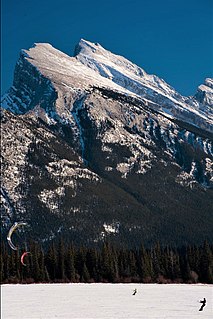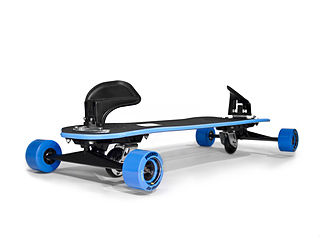
Snowboards are boards where the users places both feet usually secured, to the same board. The board itself is wider than most skis, with the ability to glide on snow. Snowboards widths are between 6 and 12 inches or 15 to 30 centimeters. Snowboards are differentiated from monoskis by the stance of the user. In monoskiing, the user stands with feet inline with direction of travel, whereas in snowboarding, users stand with feet transverse to the longitude of the board. Users of such equipment may be referred to as snowboarders. Commercial snowboards generally require extra equipment such as bindings and special boots which help secure both feet of a snowboarder, who generally ride in an upright position. These types of boards are commonly used by people at ski hills, mountains, backcountry, or resorts for leisure, entertainment, and competitive purposes in the activity called snowboarding.

Snowboarding is a recreational and competitive activity that involves descending a snow-covered slope while standing on a snowboard that is almost always attached to a rider's feet. It features in the Winter Olympic Games and Winter Paralympic Games.
Boardsports are sports that are played with some sort of board as the primary equipment. These sports take place on a variety of terrain, from paved flat-ground and snow-covered hills to water and air. Most boardsports are considered action sports or extreme sports, and thus often appeal to youth. A large proportion of youth partaking in these sports, together with aesthetic damage to property from sports like skateboarding, has led to many board sports being marginalized by the greater world of sports in the past. However, many board sports are ever-more frequently gaining mainstream recognition, and with this recognition have enjoyed wider broadcast, sponsorship and inclusion in institutional sporting events, including the Olympic Games.
The parallel turn in alpine skiing is a method for turning which rolls the ski onto one edge, allowing it to bend into an arc. Thus bent, the ski follows the turn without sliding. It contrasts with earlier techniques such as the stem Christie, which slides the ski outward from the body ("stemming") to generate sideways force. Parallel turns generate much less friction and are more efficient both in maintaining speed and minimizing skier effort.
Ski boots are footwear used in skiing to provide a way to attach the skier to skis using ski bindings. The ski/boot/binding combination is used to effectively transmit control inputs from the skier's legs to the snow.

A longboard is a type of skateboard. It is often longer than a conventional skateboard and has a wide variety of shapes. It tends to be faster because of wheel size, construction materials and more precise hardware. Longboards are commonly used for cruising, traveling and downhill racing, known as longboarding. Longboard 'dancing' and 'freestyle' are also becoming more popular styles, in which the rider uses skateboard-like motions and steps up and down the board, generally in a fluid manner.
The Arlberg technique is a progressive system that takes the skier from the snowplough turn to the parallel christie through measured stages of improvement. The system, or slightly modified versions, remains in widespread use to this day. Modern ski equipment is also capable of a more efficient turning style known as carving that uses entirely different techniques and movements. Some ski schools have started moving students directly from the snowplough to carving as early as possible, avoiding learning stemming habits that may be difficult to un-learn.

A flowboard is a variation on a skateboard, combining aspects of surfing, skating and snowboarding. There are three sizes made by the brand Flowboards: 32", for tricks and smaller riders; 36", the standard size; and 42", the large downhill bomber.

Snowkiting or kite skiing is an outdoor winter sport where people use kite power to glide on snow or ice. The skier uses a kite to give them power over large jumps. The sport is similar to water-based kiteboarding, but with the footwear used in snowboarding or skiing. The principles of using the kite are the same, but in different terrain. In the early days of snowkiting, foil kites were the most common type; nowadays many kiteboarders use inflatable kites. However, since 2013, newly developed racing foil kites seem to dominate speed races and expedition races, like Red Bull Ragnarok and the Vake mini-expedition race. Snowkiting differs from other alpine sports in that it is possible for the snowkiter to travel uphill and downhill with any wind direction. Like kiteboarding, snowkiting can be very hazardous and should be learned and practiced with care. Snowkiting is becoming increasingly popular in places often associated with skiing and snowboarding, such as Russia, Canada, Iceland, France, Switzerland, Austria, Norway, Sweden, Finland and the Northern and Central United States. The sport is becoming more diverse as adventurers use kites to travel great distances and sports enthusiasts push the boundaries of freestyle, big air, speed and back country exploration.
A leglock is a joint lock that is directed at joints of the leg such as the ankle, knee or hip joint. A leglock which is directed at joints in the foot, is sometimes referred to as a foot lock and a lock at the hip as a hip lock. Leglocks are featured, with various levels of restrictions, in combat sports and martial arts such as Sambo, Brazilian Jiu-Jitsu, catch wrestling, mixed martial arts, Shootwrestling and submission wrestling, but are banned in some sports featuring joint locks such as judo. The technique has been seen across a wide range of different combat sports and is reportedly over 2,500 years old, having been seen in the lost art of Pankration in the original Olympic Games.

A carved turn is a skiing term for the technique of turning by shifting the ski onto to its edges. When edged, the sidecut geometry causes the ski to bend into an arc, and the ski naturally follows this arc shape to produce a turning motion. The carve is efficient in allowing the skier to maintain speed because, unlike the older stem Christie and parallel turns, the skis don't create drag by sliding sideways.

A grappling hold, commonly referred to simply as a hold that in Japanese is referred to as katame-waza, is any specific grappling, wrestling, judo, or other martial art grip that is applied to an opponent. Grappling holds are used principally to control the opponent and to advance in points or positioning. The holds may be categorized by their function, such as clinching, pinning, or submission, while others can be classified by their anatomical effect: chokehold, headlock, joint-lock, or compression lock. Multiple categories may be appropriate for some of these holds.
A T-board is a longboard skateboard with only two wheels, designed to mimic the sensation of carving on a snowboard. The design differs from a traditional skateboard in a way similar to how rollerblades differ from traditional roller skates. The two wheels simulate a carving edge on pavement. The innovative design allows the board to tilt at a 60-degree angle, like a surf/snowboard, rather than the standard 25 degrees on a skateboard.

Developed during the winter of 1996 by Martin and Erik Fey, the Teleboard consists of a long, narrow snowboard, or wide ski, with two free-heel telemark bindings arranged one in front of the other at a slight angle to the longitudinal axis. This is similar to a skwal which uses fixed-heel bindings mounted in line with each other.

A freeboard is a specialist skateboard designed to closely simulate the behaviour of a snowboard. Freeboards were developed to allow snowboarders to transition to skateboarding without the need to adapt to a smaller deck and narrower wheel-base.
Some Snowboard binding rotating devices are designed to minimize the torque force that occurs when a snowboarder has one foot out of the binding and one locked on the board. The rotating device allows the snowboarder to turn the locked foot straight into the direction of the tip of the snowboard without removing their boot from the boot binding. Like this they can push themselves forward like a skateboarder. Others are designed to be free rotating the entire time you ride. Both feet are free to turn and adjust to the optimal position for a certain terrain. These subtle changes in foot position help keep stress off of ones knees as well as help ones control down the slopes.
This glossary of skiing and snowboarding terms is a list of definitions of terms and jargon used in skiing, snowboarding, and related winter sports.








